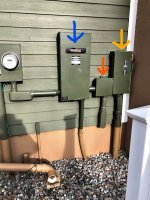Bigbri0104
Member
- Location
- New Jersey
- Occupation
- Student
Hello Again,
This question relates to differentiating between service/main disconnect. I was helping a friend on a service call and took a picture of this installation. The customer had a Generac generator installed with an automatic transfer switch. Does the automatic transfer switch become the main service disconnect and the panelboard installed inside the dwelling is now identified as sub/feeder panel correct? The reason I brought this up in the forum is when the inside panelboard cover was removed, I only viewed three wires installed - Two conductors, one each feeding a busbar and the third terminated on the neutral bar. I did not see a fourth conductor on the ground bar. Is this installation correct, because I was under the impression you needed a 4th wire on the ground bar. I just needed some clarification.
This question relates to differentiating between service/main disconnect. I was helping a friend on a service call and took a picture of this installation. The customer had a Generac generator installed with an automatic transfer switch. Does the automatic transfer switch become the main service disconnect and the panelboard installed inside the dwelling is now identified as sub/feeder panel correct? The reason I brought this up in the forum is when the inside panelboard cover was removed, I only viewed three wires installed - Two conductors, one each feeding a busbar and the third terminated on the neutral bar. I did not see a fourth conductor on the ground bar. Is this installation correct, because I was under the impression you needed a 4th wire on the ground bar. I just needed some clarification.


